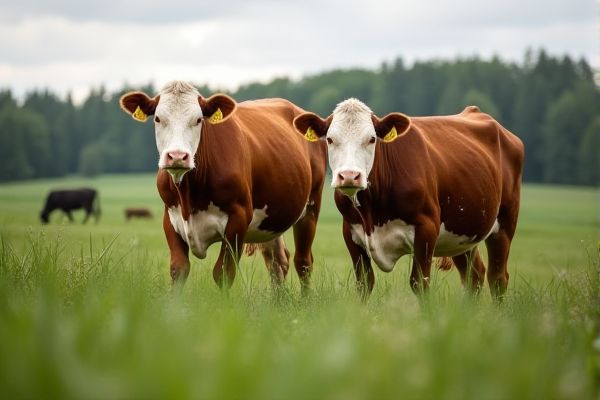
AI technology enhances livestock management by providing real-time data analysis, enabling farmers to monitor animal health more effectively. Predictive analytics can forecast disease outbreaks, allowing for timely intervention and improved herd welfare. Automated feeding systems optimize nutrition delivery, which leads to higher productivity and reduced feed costs. Behavioral monitoring through AI helps identify stressors and improve overall animal well-being, ultimately contributing to sustainable farming practices.
AI usage in livestock management
Precision Feeding
AI in livestock management offers the potential for optimizing animal health and productivity through precision feeding. By analyzing data from sensors and monitoring systems, farmers can tailor rations to meet the specific nutritional needs of each animal, such as high-producing dairy cows. This personalized approach can lead to increased milk yield and improved overall herd performance. Innovations in this field may also reduce feed waste, presenting an opportunity for cost savings and environmental benefits in agricultural practices.
Health Monitoring
AI in livestock management can enhance health monitoring by analyzing data from sensors and wearables on animals. This technology allows for early detection of diseases, improving overall herd health. For example, institutions like the University of Wisconsin-Madison are exploring AI-driven solutions to monitor cattle behavior and health indicators. The potential to reduce losses and improve productivity makes AI a valuable tool in modern farming practices.
Breeding Optimization
Using AI in livestock management offers the possibility of improving breeding optimization by analyzing genetic data to identify ideal breeding pairs. This approach can enhance traits such as disease resistance and growth rates, ultimately increasing farm productivity. Institutions like the University of Illinois are researching these advancements, showing significant potential for efficiency gains. Implementing AI-driven strategies can lead to better decision-making processes in herds and overall farm management.
Resource Management
AI technology has the potential to optimize livestock management by analyzing data for better herd health monitoring and efficient resource allocation. For example, precision farming techniques can help identify the best feeding practices based on individual animal needs, potentially enhancing growth rates and reducing feed costs. Implementation of AI systems can enable farmers to predict disease outbreaks, thus minimizing losses and improving overall productivity. Such advancements may lead to increased profitability and sustainability within the agriculture sector.
Behavior Analysis
AI can enhance livestock management by analyzing animal behavior to identify health issues early. For example, monitoring the movements and feeding patterns of cattle can lead to better health outcomes and increased productivity. The use of machine learning algorithms allows farmers to predict disease outbreaks, potentially reducing costs. Implementing these technologies may lead to higher efficiency and improved welfare in livestock operations.
Disease Prediction
AI can enhance livestock management by integrating data analysis and predictive modeling. Disease prediction algorithms can process real-time health data to identify potential outbreaks, improving animal welfare and farm productivity. For example, tools developed by institutions like Alltech focus on monitoring herd health and recommending interventions. The chance of reducing medication costs and increasing yield presents a significant advantage for farmers embracing this technology.
Automated Record Keeping
AI usage in livestock management allows for streamlined automated record keeping, which can lead to more accurate data on animal health and productivity. For example, systems can track feeding schedules and vaccination histories, enabling better decision-making for herd management. By utilizing AI, farmers could potentially improve their operational efficiency and reduce costs associated with manual record keeping. This technology offers a chance for enhanced traceability in supply chains, benefiting institutions like agricultural research organizations.
Environmental Impact Reduction
AI technology in livestock management can optimize feeding schedules, potentially leading to healthier animals and improved productivity. A reduction in feed waste may result in lower greenhouse gas emissions associated with livestock farming. For instance, utilizing AI tools at institutions like the University of California can enhance resource allocation and environmental sustainability. This integration of AI offers the chance to balance agricultural efficiency with ecological responsibility.
Labor Efficiency
AI technology can enhance labor efficiency in livestock management by automating routine tasks such as feeding, monitoring health, and tracking growth. For example, smart sensors can analyze animal behavior and alert farmers to potential health issues, reducing the need for constant manual observation. This optimization can lead to cost savings and more productive use of human resources on farms. The integration of AI tools offers the potential for improved decision-making, ultimately enhancing overall farm performance.
Supply Chain Integration
AI can enhance livestock management by optimizing feeding schedules and monitoring animal health, potentially improving productivity and reducing costs for farms. The integration of AI in the supply chain, such as in organizations like Agritech Solutions, can streamline processes from farm to market, increasing efficiency. Predictive analytics can help farmers anticipate market trends and manage inventory levels. These innovations create opportunities for better resource allocation and can lead to increased profitability.
 techknowy.com
techknowy.com